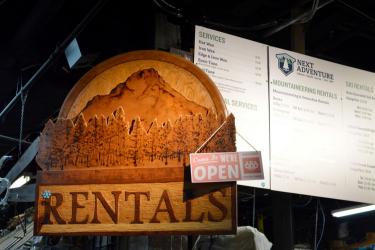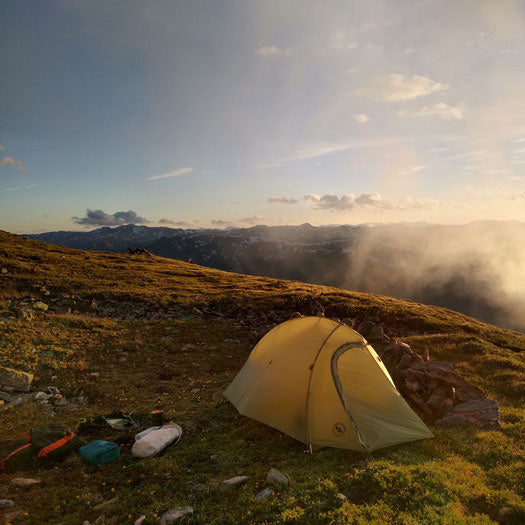
How to Choose the Right Tent for Your Next Adventure
Owning a tent can revolutionize the way you enjoy the outdoors. With the proper tent you can turn long summer days into relaxing weekends in the woods and day hikes into overnight backpacking trips. Owning a tent can give you the freedom to remain off the grid for days at a time, and the flexibility to spend the night wherever your adventure may take you. You can travel cheaper, hike further, and comfortably enjoy nature in any weather. But how to choose the proper tent? Different types of adventures will demand different types of tents; whether you’re looking for a luxurious home away from home for your next family road trip or an emergency shelter to ride out storms in the backcountry, this article will help you choose the tent that is best for you.
As with any outdoor gear purchase, there are a few key factors to consider when choosing a tent. Before diving into the nitty-gritty of tent selection, consider the following questions:
• What will this tent primarily be used for? (Will I be driving into campsites for the night, or hiking into camp?)
• How big a tent am I looking for? (How many people will be sleeping inside the tent, and how much space to do we need?)
• When do I plan to use this tent? (Only during the summer, or year-round?)
I’ll break these questions down in more detail below, then discuss some additional features you might look for in a tent and accessories you might buy to help get the most out of your purchase. Finally at the end of the article, I’ll provide some examples of my favorite tents to get you started in your tent selection process. Read on!
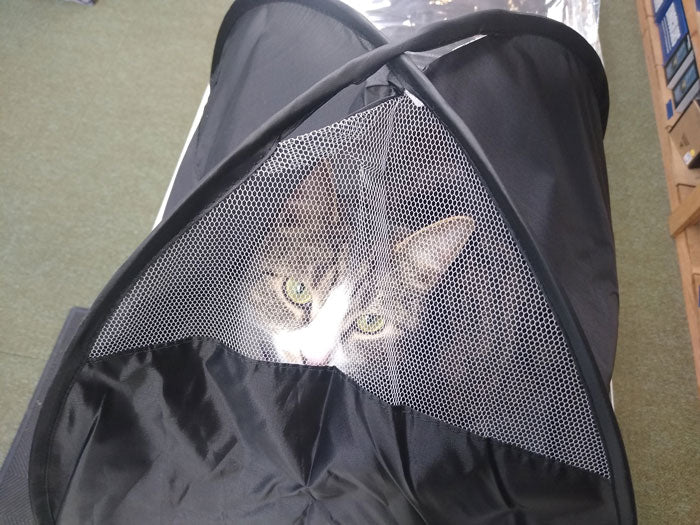 What Will this Tent be Used For?
Generally speaking, there are two types of camping: there is car camping, or front-country camping (where you can drive right into a campsite), and then there is backpacking, or back-country camping (where you’ll have to carry the tent into the campsite). Different tents will be geared toward different types of camping. Let’s examine the differences:
• Car camping tents: These tents will prioritize comfort and convenience of setup over other factors such as weight and the size of the packed tent. Car camping tents will almost always be larger and more livable than backpacking tents because they don’t need to be carried long distances. Because they are not made of ultralight materials, car camping tents are usually less expensive as well.
• Backpacking tents: These tents prioritize having a low weight and packing up small over most other factors. If you plan to carry your tent in a backpack between campsites or need to pack your tent into a small space, you will want a backpacking tent. However, these tents will be smaller and, because they are made with ultralight materials, they will also be more expensive and can require more care or effort to set up.
What Will this Tent be Used For?
Generally speaking, there are two types of camping: there is car camping, or front-country camping (where you can drive right into a campsite), and then there is backpacking, or back-country camping (where you’ll have to carry the tent into the campsite). Different tents will be geared toward different types of camping. Let’s examine the differences:
• Car camping tents: These tents will prioritize comfort and convenience of setup over other factors such as weight and the size of the packed tent. Car camping tents will almost always be larger and more livable than backpacking tents because they don’t need to be carried long distances. Because they are not made of ultralight materials, car camping tents are usually less expensive as well.
• Backpacking tents: These tents prioritize having a low weight and packing up small over most other factors. If you plan to carry your tent in a backpack between campsites or need to pack your tent into a small space, you will want a backpacking tent. However, these tents will be smaller and, because they are made with ultralight materials, they will also be more expensive and can require more care or effort to set up.
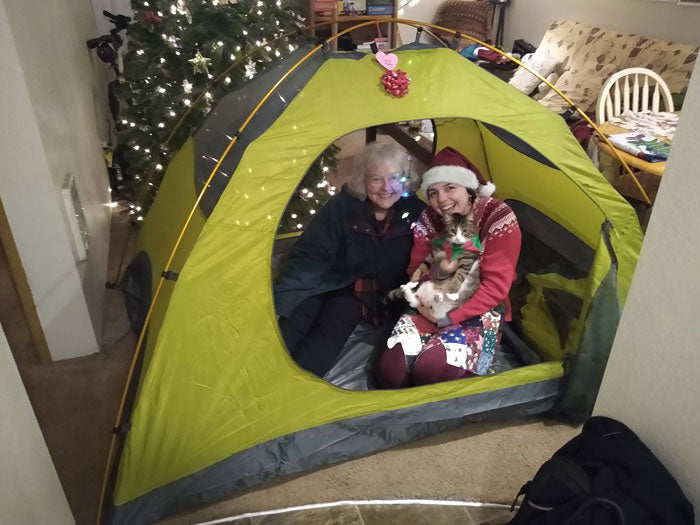 A spacious 2-person car camping tent
Many tents will clearly state whether they are made for backpacking or for front country camping trips; however, some tents will ride the line between the two. A smaller and more minimal car camping tent might make a good budget-friendly backpacking tent if you don’t mind the extra weight, and vice versa. There are a few additional factors that will help determine if a tent is intended for car camping, backpacking, or a mix of the two:
• Tent material: While many tents are made of heavy-duty, durable nylon, the lightest backpacking tents are made of silicone nylon (sil-nylon), a thinner, lighter weight, and only slightly less durable material.
• Set-up style: There are freestanding, semi-freestanding, and non-freestanding tents. Freestanding tents can be set up with only their poles; they are easy to put up and don’t require being staked into the ground (though staking a tent is always a good idea to prevent it from blowing around in the middle of the night). Non-freestanding tents can be set up with a single pole (or even a trekking pole), and rely on fabric tension through staking into the ground to remain upright. Non-freestanding tents require more effort and skill to set up, but weigh far less than tents with full pole systems and so are used by many backpackers. Semi-freestanding tents will fall somewhere between the two—they can be set up with just the tent poles, but may require stakes to hold out the corners of the tent and increase the floor size.
There are, of course, other uses for tents besides general camping. Some tents are intended to only provide shelter- either mesh houses for bugs, or awnings for rain, and are useful for setting up over a picnic table or in the backyard. And for the hardcore backcountry adventurer, there are bivy sacks—coffin-sized waterproof shelters that will fold up small enough to fit in your pocket, intended for protection in emergency situations.
A spacious 2-person car camping tent
Many tents will clearly state whether they are made for backpacking or for front country camping trips; however, some tents will ride the line between the two. A smaller and more minimal car camping tent might make a good budget-friendly backpacking tent if you don’t mind the extra weight, and vice versa. There are a few additional factors that will help determine if a tent is intended for car camping, backpacking, or a mix of the two:
• Tent material: While many tents are made of heavy-duty, durable nylon, the lightest backpacking tents are made of silicone nylon (sil-nylon), a thinner, lighter weight, and only slightly less durable material.
• Set-up style: There are freestanding, semi-freestanding, and non-freestanding tents. Freestanding tents can be set up with only their poles; they are easy to put up and don’t require being staked into the ground (though staking a tent is always a good idea to prevent it from blowing around in the middle of the night). Non-freestanding tents can be set up with a single pole (or even a trekking pole), and rely on fabric tension through staking into the ground to remain upright. Non-freestanding tents require more effort and skill to set up, but weigh far less than tents with full pole systems and so are used by many backpackers. Semi-freestanding tents will fall somewhere between the two—they can be set up with just the tent poles, but may require stakes to hold out the corners of the tent and increase the floor size.
There are, of course, other uses for tents besides general camping. Some tents are intended to only provide shelter- either mesh houses for bugs, or awnings for rain, and are useful for setting up over a picnic table or in the backyard. And for the hardcore backcountry adventurer, there are bivy sacks—coffin-sized waterproof shelters that will fold up small enough to fit in your pocket, intended for protection in emergency situations.
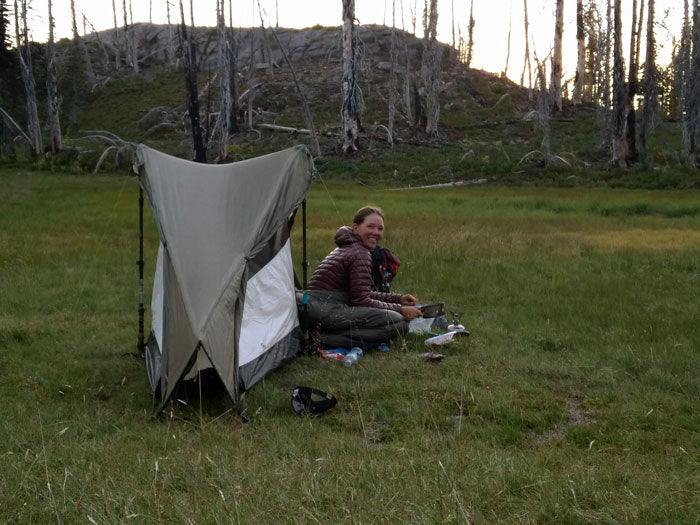 An ultralight, non-freestanding backpacking tent
How Big a Tent do I Want?
After deciding on the intended use, the next decision to make is the size of your tent. Tents are generally sized by person capacity—that is, the number of people who can comfortably sleep in a tent. Sounds pretty straightforward. If you’re camping with three other people, you’ll probably want to start by looking at 4-person tents. If you and a partner are going camping, a 2-person tent might be best.
Keep in mind though what else you might want to put in the tent. If you have a dog or want to bring your backpack inside the tent with you, or if you’re car camping and just want the extra space, you might want to choose a tent with a larger capacity. Also keep in mind that while car-camping tents are designed for comfort, backpacking tents are designed to be as light as possible—so a 1-person backpacking tent will fit exactly one person, and nothing else.
Other factors that affect the perceived size of a tent include the number of doors, and the vestibule space of a tent. A 2-person tent with two doors will feel much bigger than a 2-person tent with only one door, simply because the two people won’t have to climb over one another to enter and exit the tent. Vestibule space refers to the area outside the mesh body of the tent, but underneath the rain fly (the outer waterproof covering). You probably wouldn’t sleep under a tent vestibule, but you can certainly use the space to store shoes and jackets, and other gear.
An ultralight, non-freestanding backpacking tent
How Big a Tent do I Want?
After deciding on the intended use, the next decision to make is the size of your tent. Tents are generally sized by person capacity—that is, the number of people who can comfortably sleep in a tent. Sounds pretty straightforward. If you’re camping with three other people, you’ll probably want to start by looking at 4-person tents. If you and a partner are going camping, a 2-person tent might be best.
Keep in mind though what else you might want to put in the tent. If you have a dog or want to bring your backpack inside the tent with you, or if you’re car camping and just want the extra space, you might want to choose a tent with a larger capacity. Also keep in mind that while car-camping tents are designed for comfort, backpacking tents are designed to be as light as possible—so a 1-person backpacking tent will fit exactly one person, and nothing else.
Other factors that affect the perceived size of a tent include the number of doors, and the vestibule space of a tent. A 2-person tent with two doors will feel much bigger than a 2-person tent with only one door, simply because the two people won’t have to climb over one another to enter and exit the tent. Vestibule space refers to the area outside the mesh body of the tent, but underneath the rain fly (the outer waterproof covering). You probably wouldn’t sleep under a tent vestibule, but you can certainly use the space to store shoes and jackets, and other gear.
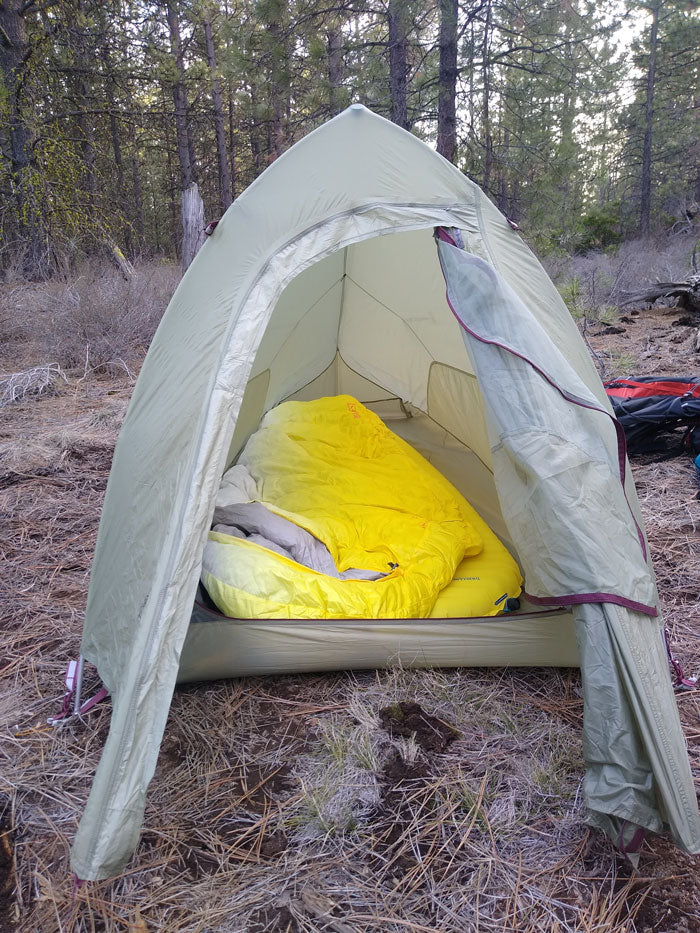 A small, single door/single vestibule 1-person backpacking tent
When do I plan to use this tent?
The final factor in choosing a tent is the timing of the camping trip. All tents are given a rating of either 3 or 4 seasons (if a rating isn’t provided, it’s safe to assume that it is a 3-season tent). 3-season tents are usually composed of a mesh tent body and a waterproof rain cover and are intended for use from Spring through Fall; 4-season tents are a single layer of mostly airtight material and are therefore warmer and more insulative, and are meant to be used year-round.
Though extra insulation may be necessary in extreme winter conditions, be careful when choosing a 4-season tent. Because they are airtight, they are not well-ventilated and can quickly allow moisture to build inside the tent walls throughout the night. There are relatively few situations in which a 4-season tent is truly necessary, and if you have the right clothing, sleeping pad, and sleeping bag, many 3-season tents work fine for mild-weather winter camping.
A small, single door/single vestibule 1-person backpacking tent
When do I plan to use this tent?
The final factor in choosing a tent is the timing of the camping trip. All tents are given a rating of either 3 or 4 seasons (if a rating isn’t provided, it’s safe to assume that it is a 3-season tent). 3-season tents are usually composed of a mesh tent body and a waterproof rain cover and are intended for use from Spring through Fall; 4-season tents are a single layer of mostly airtight material and are therefore warmer and more insulative, and are meant to be used year-round.
Though extra insulation may be necessary in extreme winter conditions, be careful when choosing a 4-season tent. Because they are airtight, they are not well-ventilated and can quickly allow moisture to build inside the tent walls throughout the night. There are relatively few situations in which a 4-season tent is truly necessary, and if you have the right clothing, sleeping pad, and sleeping bag, many 3-season tents work fine for mild-weather winter camping.
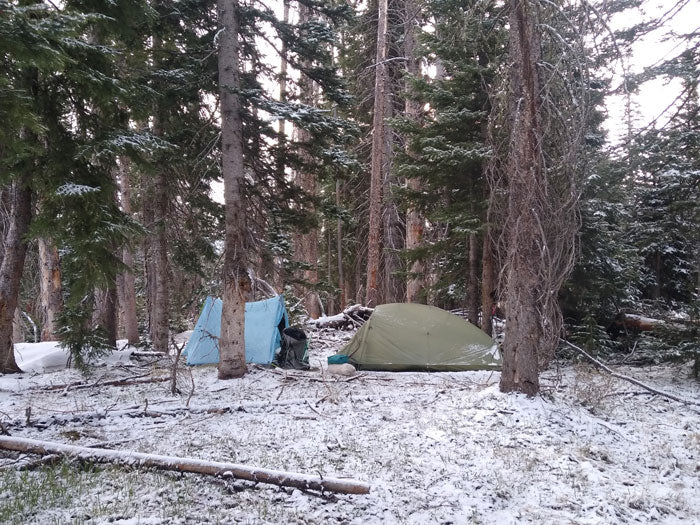 These 3-season tents were fine in this mild, early-winter snowstorm
Tent Accessories, and other Odds and Ends
Once you have selected a tent, there are a few other accessories you may wish to buy to protect your product. The first is a tent footprint. A tent footprint is an additional layer of material that is placed on the ground below the tent and protects the tent floor from anything sharp that may be in the ground. If you use the tent frequently or intend for it to last for a long time, using a footprint is a good idea. Though footprints can be expensive (they are usually made specifically to fit the tent), it is less expensive to replace a torn tent footprint than to replace a torn tent.
It is also worth investing in a basic tent repair kit, particularly if you’re planning to rely on the tent in the backcountry. Things like fabric patches, pole splints, and replacement shock cord can come in handy and keep the tent useable during longer trips when alternative shelter may not be an option.
These 3-season tents were fine in this mild, early-winter snowstorm
Tent Accessories, and other Odds and Ends
Once you have selected a tent, there are a few other accessories you may wish to buy to protect your product. The first is a tent footprint. A tent footprint is an additional layer of material that is placed on the ground below the tent and protects the tent floor from anything sharp that may be in the ground. If you use the tent frequently or intend for it to last for a long time, using a footprint is a good idea. Though footprints can be expensive (they are usually made specifically to fit the tent), it is less expensive to replace a torn tent footprint than to replace a torn tent.
It is also worth investing in a basic tent repair kit, particularly if you’re planning to rely on the tent in the backcountry. Things like fabric patches, pole splints, and replacement shock cord can come in handy and keep the tent useable during longer trips when alternative shelter may not be an option.
 Conclusion
And that’s a wrap on tents! As a quick recap: the important factors to consider when choosing a tent are type of use, tent size, and camping season. And I will add—though shopping online is very possible, the best way to select a tent is to actually go into your local outdoor store and see them set up. Climb inside the tent and imagine sleeping in there. Take the tent down, pack it away, and then put it back up. Ask questions and read reviews before buying. Then, get out there and go camping!
Conclusion
And that’s a wrap on tents! As a quick recap: the important factors to consider when choosing a tent are type of use, tent size, and camping season. And I will add—though shopping online is very possible, the best way to select a tent is to actually go into your local outdoor store and see them set up. Climb inside the tent and imagine sleeping in there. Take the tent down, pack it away, and then put it back up. Ask questions and read reviews before buying. Then, get out there and go camping!
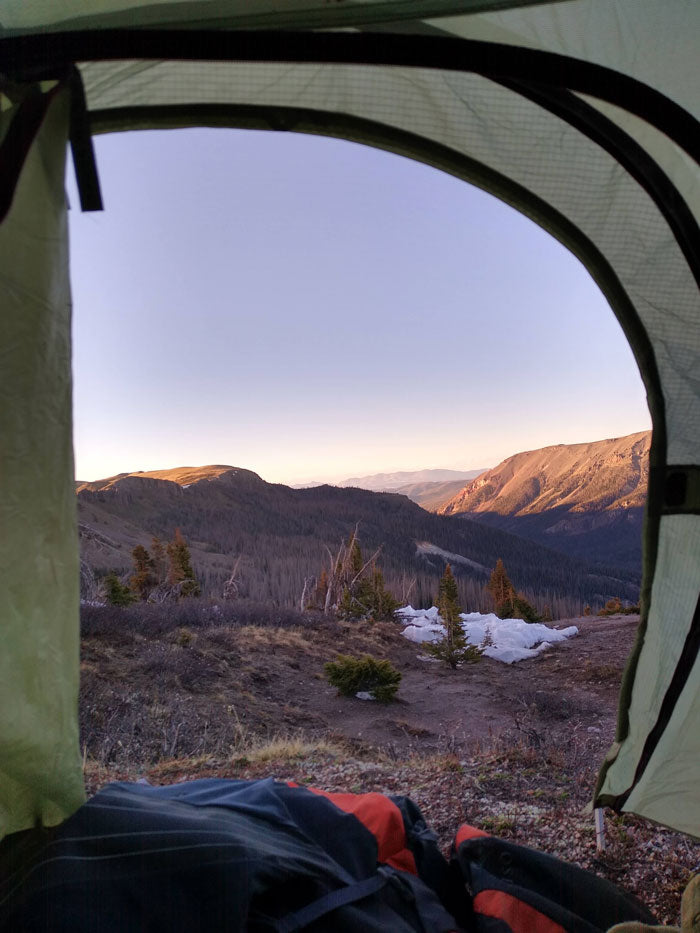 Staff Picks
Staff Picks
 What Will this Tent be Used For?
Generally speaking, there are two types of camping: there is car camping, or front-country camping (where you can drive right into a campsite), and then there is backpacking, or back-country camping (where you’ll have to carry the tent into the campsite). Different tents will be geared toward different types of camping. Let’s examine the differences:
• Car camping tents: These tents will prioritize comfort and convenience of setup over other factors such as weight and the size of the packed tent. Car camping tents will almost always be larger and more livable than backpacking tents because they don’t need to be carried long distances. Because they are not made of ultralight materials, car camping tents are usually less expensive as well.
• Backpacking tents: These tents prioritize having a low weight and packing up small over most other factors. If you plan to carry your tent in a backpack between campsites or need to pack your tent into a small space, you will want a backpacking tent. However, these tents will be smaller and, because they are made with ultralight materials, they will also be more expensive and can require more care or effort to set up.
What Will this Tent be Used For?
Generally speaking, there are two types of camping: there is car camping, or front-country camping (where you can drive right into a campsite), and then there is backpacking, or back-country camping (where you’ll have to carry the tent into the campsite). Different tents will be geared toward different types of camping. Let’s examine the differences:
• Car camping tents: These tents will prioritize comfort and convenience of setup over other factors such as weight and the size of the packed tent. Car camping tents will almost always be larger and more livable than backpacking tents because they don’t need to be carried long distances. Because they are not made of ultralight materials, car camping tents are usually less expensive as well.
• Backpacking tents: These tents prioritize having a low weight and packing up small over most other factors. If you plan to carry your tent in a backpack between campsites or need to pack your tent into a small space, you will want a backpacking tent. However, these tents will be smaller and, because they are made with ultralight materials, they will also be more expensive and can require more care or effort to set up.
 A spacious 2-person car camping tent
A spacious 2-person car camping tent An ultralight, non-freestanding backpacking tent
An ultralight, non-freestanding backpacking tent A small, single door/single vestibule 1-person backpacking tent
A small, single door/single vestibule 1-person backpacking tent These 3-season tents were fine in this mild, early-winter snowstorm
These 3-season tents were fine in this mild, early-winter snowstorm Conclusion
And that’s a wrap on tents! As a quick recap: the important factors to consider when choosing a tent are type of use, tent size, and camping season. And I will add—though shopping online is very possible, the best way to select a tent is to actually go into your local outdoor store and see them set up. Climb inside the tent and imagine sleeping in there. Take the tent down, pack it away, and then put it back up. Ask questions and read reviews before buying. Then, get out there and go camping!
Conclusion
And that’s a wrap on tents! As a quick recap: the important factors to consider when choosing a tent are type of use, tent size, and camping season. And I will add—though shopping online is very possible, the best way to select a tent is to actually go into your local outdoor store and see them set up. Climb inside the tent and imagine sleeping in there. Take the tent down, pack it away, and then put it back up. Ask questions and read reviews before buying. Then, get out there and go camping!
 Staff Picks
Staff Picks

